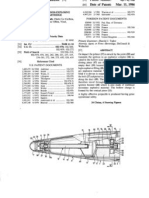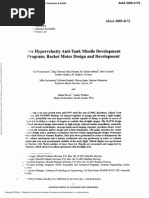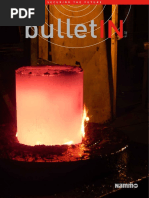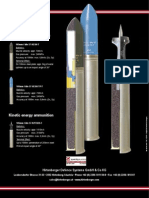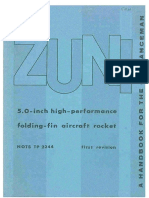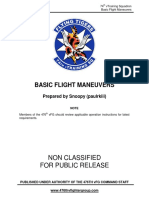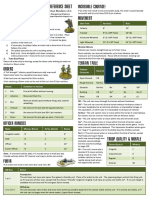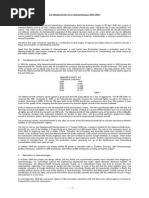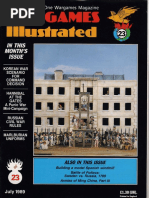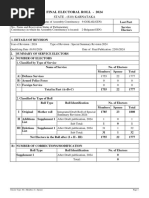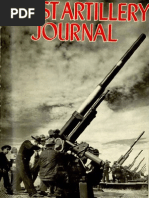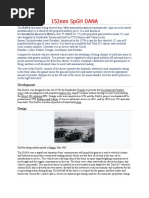476th VFG Weapon Fact Sheet 5
476th VFG Weapon Fact Sheet 5
Uploaded by
Miguel SanchezCopyright:
Available Formats
476th VFG Weapon Fact Sheet 5
476th VFG Weapon Fact Sheet 5
Uploaded by
Miguel SanchezOriginal Description:
Copyright
Available Formats
Share this document
Did you find this document useful?
Is this content inappropriate?
Copyright:
Available Formats
476th VFG Weapon Fact Sheet 5
476th VFG Weapon Fact Sheet 5
Uploaded by
Miguel SanchezCopyright:
Available Formats
UNCLASSIFIED
476th vFighter Group
Weapon Fact Sheet 5: CBU-97 Sensor Fused Weapon
INTRODUCTION
The CBU-97 Sensor Fused Weapon is a United
States Air Force 1,000-pound-class (450 kg)
non-guided (free fall) Cluster Bomb Unit
(CBU). It was developed and produced by
Textron Defence Systems and is designed to be
effective against all types of armoured vehicles
currently in service across the world. The
CBU-97 was rst deployed during Operation
Allied Force when the United States and
NATO entered the Kosovo War, but were not
used. Sensor-fused weapons were rst red in
combat during the 2003 invasion of Iraq.
DESIGN
The CBU-97 is designed to be deployed by US
Air Force tactical aircraft from altitudes of 200
feet (60 m) Above Ground Level (AGL) to
20,000 feet (6100 m) Above Mean Sea Level
(AMSL) at speeds of 250 to 650 knots (460 to
1,200 km/h). It is a free-falling weapon and
relies on the aircraft to aim it before it drops.
SPECIFICATION
The CBU-97 consists of an SUU-66/B tactical
munition dispenser that contains 10 BLU-108
submunitions. Each submunition contains four
hockey-puck-shaped sensor-fused projectiles
called skeets. Once deployed the skeets have
the ability to detect targets and re an
explosively formed penetrator. The weapon is 7
ft. 7 inches (234 cm) in length, has a diameter
of 16 inches (40 cm) and weighs
approximately 930 lbs. (420Kg). The base cost
for each CBU-97 is US$ 360,000. When the
CBU-97 is used in conjunction with the Wind
Corrected Munitions Dispenser tail kit, it is
designated the CBU-105.
476th vFighter Group
UNCLASSIFIED
UNCLASSIFIED
OPERATION
As the CBU-97 approaches its designated aim-point, at the pre-set height of function (HOF) the
dispenser skin is severed into three panels by an explosive cutting charge. The slipstream peels
away these panels, exposing the 10 BLU-108 submunitions. An airbag ejects the forward ve
submunitions, then ve in the aft bay. Unlike the CBU-87 the CBU-97 does not spin, and therefore
has no RPM settings. Furthermore the HOF setting does not affect the coverage pattern of the
BLUs/skeets when they deploy as it does for the CBU-87 due to the way in which the BLUs
operate.
BLU-108/B Submunition
The BLU-108/B submunition is used in the CBU-97/105 SFW and variants of the Joint Stand-Off
Weapon (JSOW). The BLU-108/B submunition weighs approximately 60 pounds, contains four
warheads (skeets), an orientation and stabilisation system, a radar altimeter and a small rocket
motor. After the BLU-108 is released from its dispenser, it is decelerated by a drogue parachute,
and then oriented by a main parachute to a vertical position. The rocket motor within the
submunition res, imparting spin and upward velocity, upon reaching the proper spin rate and
altitude, the 4 heat-sensing Skeets are released at right angles. The dual-mode active (laser) and
passive (infrared) sensors mounted on the skeet provide optimal performance against a wide variety
of targets. The active sensor performs target proling, while the passive sensor detects the target's
thermal signature. When a valid target is detected, the EFP is red, which defeats the target from the
top.
Each warhead res an explosively-formed projectile triggered by a two-colour infrared sensor. At a
pre-set altitude sensed by a radar altimeter, a rocket motor res to spin the submunition and initiate
an ascent. The submunition then releases its four projectiles, which are lofted over the target area.
476th vFighter Group
UNCLASSIFIED
UNCLASSIFIED
The projectile's sensor detects a vehicle's infrared signature, and an explosively formed penetrator
res at the heat source. If no target is detected, the projectiles automatically self-destruct after a pre-
set time interval, in order to help limit collateral damage caused by unexploded ordnance.
The BLU-108 contains 4 smart Skeet warheads. The skeet's Explosively Formed Penetrator (EFP)
is the lethal component of the warhead.
The one pound copper EFP, moving at
hypersonic speeds, performs a kinetic
energy kill of the target, thus minimising
collateral damage. Each skeet warhead
also incorporates a fragmentation ring to
defeat soft targets and their ancillary
equipment. The Skeet's centre core
projectile is designed to defeat heavy
armoured vehicles. Effective against both
hard and soft targets, the BLU-108 target
set includes:
Main battle tanks
Mobile missile launchers
Air defence sites
Parked aircraft
Armoured personnel carriers
Littoral targets
The skeets are equipped with two built-in self-
destruct features to help reduce the risk of
unexploded ordnance being left on the
battleeld. A timeout feature instructs the Skeet
to self-destruct within seconds if a valid target
has not been detected. An altitude feature
causes detonation to happen a short distance
above the ground. These important features
signicantly reduce the potential for
unexploded ordnance on the battleeld-an
issue for many older submunition products.
Textron Industries CBU-97/BLU-108/B Demo Video
476th vFighter Group
UNCLASSIFIED
UNCLASSIFIED
EMPLOYMENT
The CBU-97 and its BLU-108/B submunitions in DCS are a highly effective anti-armour weapon
system, especially against large formations of main battle tanks.
While HOF does not alter the effective area of the CBU-97 as it does with the CBU-87 it is still
very important. With the CBU-97 HOF controls only the altitude at which the canisters open and
begin dispensing the BLU-108/B submunitions, the submunitions themselves ALWAYS function
the same way and disperse their
skeets from the same altitude.
Therefore HOF only real effect
is on the time the BLU-108s
will decent on their parachutes
before they activate their rocket
motors and spin up to deploy
the skeets, and as the this
always occurs at around 200 ft.
AGL, it can have a large impact
on the time to impact and the
accuracy of the weapon
(especially in high winds).
The lowest practical HOF
should always be set for the
CBU-97, (usually 700-900 ft.)
but the terrain in the target area
should be taken in to account as
mountainous areas may
necessitate a higher HOF than
normal to ensure proper CBU
operation. If the HOF is set too
low, it may result in the BLU-108/B submunitions not having sufcient time to function and
therefore they will impact the ground without deploying their skeets.
It should be noted that while the skeets do have an anti-material fragmentation function, it is a
secondary capability and the CBU-87 should be used in cases where soft skinned vehicles are the
primary target.
476th vFighter Group
UNCLASSIFIED
You might also like
- Arn5011 - Atp 3-09x30 Final WebDocument204 pagesArn5011 - Atp 3-09x30 Final WebjimNo ratings yet
- Horse, Foot and GunsDocument60 pagesHorse, Foot and Gunsairfix1999100% (14)
- The Portuguese Army of The Napoleonic Wars Part3Document52 pagesThe Portuguese Army of The Napoleonic Wars Part3sstanislav232380% (5)
- TM - 43 0001 28 13Document3 pagesTM - 43 0001 28 13Nicole Duchaine50% (2)
- HDS 120mm SystemDocument2 pagesHDS 120mm Systemrahavom20No ratings yet
- SFRJ ProjectileDocument21 pagesSFRJ ProjectileDhimas Afihandarin100% (1)
- USSBS Report 61, Military Analysis Division, Air Forces Allied With The United States in The War Against JapanDocument12 pagesUSSBS Report 61, Military Analysis Division, Air Forces Allied With The United States in The War Against JapanJapanAirRaidsNo ratings yet
- Us Ngic Iraq Small Arms 2004 - WikileaksDocument13 pagesUs Ngic Iraq Small Arms 2004 - WikileaksmclmmNo ratings yet
- Handbook 991 Chanard Incendiary Bomb 1919Document6 pagesHandbook 991 Chanard Incendiary Bomb 1919richardwb1100% (1)
- LM2000AVMDocument18 pagesLM2000AVMweter44No ratings yet
- Yemen Landmine GuideDocument41 pagesYemen Landmine GuidesubjefeoperacionesNo ratings yet
- Japanese Ammunition Leaflets Section J - Japanese Chemical & Smoke StoresDocument38 pagesJapanese Ammunition Leaflets Section J - Japanese Chemical & Smoke StoresBOUGAINVILLE1100% (2)
- Cluster Munition Information Chart 1108Document2 pagesCluster Munition Information Chart 1108polkmijnNo ratings yet
- Remote Bombs WW2Document26 pagesRemote Bombs WW2ekielmanNo ratings yet
- Francois Brandt - Armour-Piercing High-Explosive Projectile With CartridgeDocument13 pagesFrancois Brandt - Armour-Piercing High-Explosive Projectile With CartridgeJellomaNo ratings yet
- Artilery-Systems STC Delta Production-Catalogue 01.01.2015Document8 pagesArtilery-Systems STC Delta Production-Catalogue 01.01.2015Johnny Warhawk ONeill100% (1)
- College of Air Warfare - CLUSTER BOMBSDocument35 pagesCollege of Air Warfare - CLUSTER BOMBSCam EllNo ratings yet
- Air To SurfaceDocument7 pagesAir To SurfaceHVNo ratings yet
- Catalogo OnlineDocument22 pagesCatalogo OnlineLuis Gabriel Gomez100% (1)
- Common Smart SubmunitionDocument11 pagesCommon Smart SubmunitionАлександар Нуждић50% (2)
- U.S.S.R. Submunition Canisters, Mine Dispensing, Expendable, Kso-1 and Kso-1SDocument20 pagesU.S.S.R. Submunition Canisters, Mine Dispensing, Expendable, Kso-1 and Kso-1SMarso A OtsoNo ratings yet
- Expal f11 EngDocument34 pagesExpal f11 Engmrubini4892No ratings yet
- FM 3-23.25 Shoulder Launched Munitions 2006Document12 pagesFM 3-23.25 Shoulder Launched Munitions 2006lowtech410% (1)
- Rarefaction Wave Gun Tank Main Armament DemonstratorDocument5 pagesRarefaction Wave Gun Tank Main Armament Demonstratordiana nistoranNo ratings yet
- Hypervelocity Anti-Tank Missile Development Ibrogram Rocket Motor Design and DevelopmentDocument16 pagesHypervelocity Anti-Tank Missile Development Ibrogram Rocket Motor Design and Developmenttotenkopf0424No ratings yet
- Vietnam ProjosDocument271 pagesVietnam Projosjbart252No ratings yet
- Amm 4.5inch British HowitzerDocument6 pagesAmm 4.5inch British HowitzerenricoNo ratings yet
- Nammo Bulletin 2014Document13 pagesNammo Bulletin 2014Dmitry Karpov0% (1)
- OP 1415 RKT AssyDocument152 pagesOP 1415 RKT Assyjbart252100% (1)
- 20 X 138 BDocument3 pages20 X 138 Bmusgrave762100% (1)
- Truvelo SR Brochure 2011Document12 pagesTruvelo SR Brochure 2011Dark God100% (1)
- 30mm GAU 8 A PGU 13 B HEI PGU 14 B API PGU 15 B TPDocument2 pages30mm GAU 8 A PGU 13 B HEI PGU 14 B API PGU 15 B TP劉永賢No ratings yet
- 20mm Ares (Iaa)Document4 pages20mm Ares (Iaa)Enriquenf100% (1)
- 15mm MG 151 MunitionDocument16 pages15mm MG 151 MunitionAncarion100% (1)
- P Ne It Cuua Piooj S&Uucea.: Technical - LibraryDocument27 pagesP Ne It Cuua Piooj S&Uucea.: Technical - LibraryAmiVolat100% (1)
- Afganistan Hazard Landmine and Explosive GuideDocument236 pagesAfganistan Hazard Landmine and Explosive GuidesubjefeoperacionesNo ratings yet
- Navord Op 1668 Ital-French OrdDocument218 pagesNavord Op 1668 Ital-French OrdDetN8r100% (2)
- Model For Ballistic Fragmentation and Behind-Armor Debris: A.L. Yarin !,, I.V. Roisman!,1, K. Weber", V. Hohler"Document31 pagesModel For Ballistic Fragmentation and Behind-Armor Debris: A.L. Yarin !,, I.V. Roisman!,1, K. Weber", V. Hohler"Anwaar EllahiNo ratings yet
- Dinamit Nobel DefenceDocument59 pagesDinamit Nobel DefenceNash7777100% (2)
- TM - 43 0001 38Document11 pagesTM - 43 0001 38Hollower1No ratings yet
- SAS Research Note 55Document4 pagesSAS Research Note 55John ThomasNo ratings yet
- Fuze For HL Bomb Usa 1945Document35 pagesFuze For HL Bomb Usa 1945FrancescoNo ratings yet
- War 2006 Threat Factsheet Libano Cluster Bomb by UnmaccDocument48 pagesWar 2006 Threat Factsheet Libano Cluster Bomb by UnmaccsubjefeoperacionesNo ratings yet
- Cluster Poster Syria Detail1.6-1Document1 pageCluster Poster Syria Detail1.6-1armsresearch0% (1)
- GRM 20Document2 pagesGRM 20jakalae5263No ratings yet
- Aircraft OrdnanceDocument30 pagesAircraft Ordnancemcroberts100% (1)
- A12.CD.M2.P1 Civil Defence Manual of Basic Training Volume II Basic Chemical WarfareDocument66 pagesA12.CD.M2.P1 Civil Defence Manual of Basic Training Volume II Basic Chemical WarfarearnoldvvNo ratings yet
- TM 9-227 20 MM Automatic Gun M1 and 20mm Aircraft Automatic Gun AN-M2 (42-04-02) PDFDocument52 pagesTM 9-227 20 MM Automatic Gun M1 and 20mm Aircraft Automatic Gun AN-M2 (42-04-02) PDFBlockhaj smashNo ratings yet
- Ammo Id ReviewerDocument10 pagesAmmo Id Revieweressica.landoNo ratings yet
- 105/120/125 MM PELE Firing Results: Dr. Lutz Börngen, Wolfgang SteinDocument29 pages105/120/125 MM PELE Firing Results: Dr. Lutz Börngen, Wolfgang SteinRamonNo ratings yet
- Mil DTL 45195 Revision FDocument51 pagesMil DTL 45195 Revision FnanocardosoNo ratings yet
- Squashhead Ammunition: 105mm / Mle 57 HESH-TDocument4 pagesSquashhead Ammunition: 105mm / Mle 57 HESH-TyararaNo ratings yet
- 3.7 Inch AA ShellDocument1 page3.7 Inch AA ShellRymondNo ratings yet
- M85 ReportDocument64 pagesM85 ReportJose A. MartínezNo ratings yet
- Mortar Ammo M821 Series USADocument1 pageMortar Ammo M821 Series USAFrancescoNo ratings yet
- Explosia Kat Speciality enDocument28 pagesExplosia Kat Speciality enTri DoNo ratings yet
- 00c WPN ID Mkgs James BevanDocument5 pages00c WPN ID Mkgs James BevanJohn ShearerNo ratings yet
- John Niles Et Al - Mitigating Shaped Charge Jet ImpactDocument20 pagesJohn Niles Et Al - Mitigating Shaped Charge Jet ImpactMermaczNo ratings yet
- 1959 D149zuni 5.0 Ffar PDFDocument40 pages1959 D149zuni 5.0 Ffar PDFJuan Palomo (Pajarito)No ratings yet
- Functional Composite Materials: Manufacturing Technology and Experimental ApplicationFrom EverandFunctional Composite Materials: Manufacturing Technology and Experimental ApplicationNo ratings yet
- Gun Trader's Guide, Thirty-Fifth Edition: A Comprehensive, Fully Illustrated Guide to Modern Firearms with Current Market ValuesFrom EverandGun Trader's Guide, Thirty-Fifth Edition: A Comprehensive, Fully Illustrated Guide to Modern Firearms with Current Market ValuesNo ratings yet
- Cannon in Canada, Province by Province, Volume 9: Alberta, Saskatchewan, Yukon, Northwest Territories, and NunavutFrom EverandCannon in Canada, Province by Province, Volume 9: Alberta, Saskatchewan, Yukon, Northwest Territories, and NunavutNo ratings yet
- The Development of Armor-piercing Shells with Suggestions for their ImprovementFrom EverandThe Development of Armor-piercing Shells with Suggestions for their ImprovementNo ratings yet
- 476th VFG Weapon Fact Sheet 5Document4 pages476th VFG Weapon Fact Sheet 5Miguel SanchezNo ratings yet
- 74th VTS Formation Guide Change 3 PDFDocument29 pages74th VTS Formation Guide Change 3 PDFMiguel Sanchez100% (2)
- 74th VTS Basic Flight Maneuvers Change 2 PDFDocument14 pages74th VTS Basic Flight Maneuvers Change 2 PDFMiguel SanchezNo ratings yet
- 74th VTS A-10 Air-to-Air Refueling Guide Change 1 PDFDocument11 pages74th VTS A-10 Air-to-Air Refueling Guide Change 1 PDFMiguel SanchezNo ratings yet
- Exz110 enDocument242 pagesExz110 enMiguel SanchezNo ratings yet
- 08 Int Sid-Star ChartDocument12 pages08 Int Sid-Star ChartMiguel SanchezNo ratings yet
- Sycj PDFDocument3 pagesSycj PDFMiguel Sanchez100% (1)
- Military Science (Ms-2) Naval Organization: Name of PresenterDocument15 pagesMilitary Science (Ms-2) Naval Organization: Name of PresenterStewart StevenNo ratings yet
- AcronimosDocument4 pagesAcronimosAmelie BreakNo ratings yet
- Ada 055593Document38 pagesAda 055593youyoussef672No ratings yet
- Light InfantryDocument58 pagesLight InfantryPraveen KumarNo ratings yet
- How Does A Cannon WorkDocument2 pagesHow Does A Cannon WorkKênh Quân Sự Tổng HợpNo ratings yet
- Flames of War - Fow - x.0 - Intelligence Briefing - Division AzulDocument20 pagesFlames of War - Fow - x.0 - Intelligence Briefing - Division AzulMatthieu BrevetNo ratings yet
- The Russian Naval Infantry - Increasing Amphibious Warfare CapabilitiesDocument8 pagesThe Russian Naval Infantry - Increasing Amphibious Warfare CapabilitiesAlex TarasovNo ratings yet
- Hex Command AncientsDocument12 pagesHex Command AncientsTerry CabakNo ratings yet
- Italian Wars Introduction WSSDocument4 pagesItalian Wars Introduction WSSAndrew SmithNo ratings yet
- Ba Modern Playsheet v3.1Document7 pagesBa Modern Playsheet v3.1Roberto Martinez Alejandre100% (1)
- Field Artillery Journal - Jun 1944Document67 pagesField Artillery Journal - Jun 1944CAP History LibraryNo ratings yet
- The Messerschmitt AG in Oberammergau (English)Document7 pagesThe Messerschmitt AG in Oberammergau (English)Dos Santos FranciscoNo ratings yet
- Info 2011 10ENDocument28 pagesInfo 2011 10ENpgp000100% (3)
- Wargames Illustrated #023Document60 pagesWargames Illustrated #023Анатолий Золотухин100% (1)
- Position Designation and Contact InformationDocument2 pagesPosition Designation and Contact InformationLeroy Jethro Gibbs NicosiaNo ratings yet
- Final Electoral Roll - 2024: State - (S10) KarnatakaDocument124 pagesFinal Electoral Roll - 2024: State - (S10) KarnatakaVinod DadannavarNo ratings yet
- Coast Artillery Journal - Apr 1940Document116 pagesCoast Artillery Journal - Apr 1940CAP History Library100% (1)
- Kargil Conflict ArticlesDocument51 pagesKargil Conflict Articlesomkar_puri5277No ratings yet
- Deadzone 3.0 Enforcers 100pt ListDocument2 pagesDeadzone 3.0 Enforcers 100pt ListchinksterNo ratings yet
- Air To Air HelicopterDocument58 pagesAir To Air HelicopterTuckctNo ratings yet
- Flipbook DDaOB 3.1 A4 - BasicDocument14 pagesFlipbook DDaOB 3.1 A4 - BasicJos van der LindenNo ratings yet
- 152mm SPGH DANADocument4 pages152mm SPGH DANAjason maiNo ratings yet
- Alpha Profile FormatDocument15 pagesAlpha Profile FormatSenior Software Engineer Emil RodriguezNo ratings yet
- CADIAN SHOCK TROOPS ARMY LIST v1.56Document4 pagesCADIAN SHOCK TROOPS ARMY LIST v1.56Gabriel NguyenNo ratings yet
- CMI Defence Cockerill CT CV 105HPDocument4 pagesCMI Defence Cockerill CT CV 105HPArief Yunan Priyoutomo100% (1)
- Epic OrkDocument5 pagesEpic Orkal mailNo ratings yet














